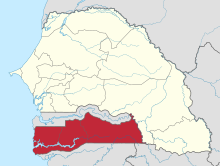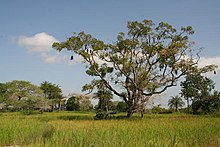Casamance
The Casamance is a landscape that stretches along the river of the same name in southern Senegal between Gambia and Guinea-Bissau . It differs from the rest of Senegal primarily in its greater abundance of water and stronger vegetation as well as in the composition of the population. The inhabitants of the Casamance - especially those from the Diola ethnic group - have a strong identity of their own. Aline Sitoé Diatta led an uprising against the French colonial power as early as 1942 and thus became the most famous resistance fighter against colonialism in Senegal.
Geography and climate
The Casamance is a landscape in southwest Senegal, bordered by Gambia to the north and Guinea-Bissau to the south. The border in the west is the Atlantic Ocean and in the east the Koulountou and the Gambia . The area of Casamance makes up one seventh of the total area of Senegal.
The Casamance is divided into three regions, each named after the prefecture cities. These are the Ziguinchor region (formerly called Lower Casamance) in the west, the Sédhiou region, newly created in 2008, in the center and the Kolda region in the east. The regions are further subdivided into departments . The names of the departments are based on the main town with the seat of the department prefecture.
The rainy season in Casamance lasts approximately four to five months and is between June and October. Here more precipitation falls than in the north of Senegal. Unlike in the Sahel- dominated north of Senegal, the vegetation consists of tropical rainforest .
In the lower reaches of the Casamance and the northern tributary Soungrougrou , the tidal current is noticeable up to 200 kilometers inland from the coast and has washed out the river bed to a width of 4000 meters. The shore zones are accompanied by a mangrove system , which branches out further and further towards the mouth in Bolongs and forms an amphibious type of landscape. Some bolongs sometimes extend 20 or 30 kilometers inland.
population
The last censuses showed the following population figures for the regions of Casamance:
| region | VZ 1988 | VZ 2002 | VZ 2013 |
|---|---|---|---|
| Kolda | 591.833 | 836.230 | 662.455 |
| Sédhiou | - | - | 452.994 |
| Ziguinchor | 398,337 | 437.986 | 549.151 |
| Casamance together | 890.170 | 1,274,216 | 1,664,600 |
The Casamance is mainly inhabited by three ethnic groups:
- The Diola are concentrated in the Ziguinchor region. The number of speakers in Senegal has been given for many years (undated) as 340,000.
- The Mandinka have the Sédhiou region as their settlement focus. The number of speakers in Senegal was given as 669,000 in 2006.
- The Peul make up the majority of the population in the Kolda region . However, these can also be found in large parts of the country further north. The number of speakers in Senegal was given as 3,450,000 in 2006.
There are also smaller settlement areas for other ethnic groups. The Wolof , who are the largest ethnic group in Senegal, only play a minor role in Casamance. In rural areas they have separated themselves from the rest of the population in their own villages. This separation is often recognizable by an addition in the names of the villages such as Louida Diola and Loudia Ouolof or Diakene Diola and Diakene Ouolof , villages in the Oussouye department .
The majority of the population, 75%, profess Islam . 17% are Christians , mostly Catholics (dioceses of Kolda and Ziguinchor ). 8% profess regional cults. In contrast to other parts of Senegal, Casamance has a larger proportion of Christians in the population.
The language of the Casamance also differs from the rest of Senegal. The Crioulo , a Portuguese- based African Creole language that goes back to the time of the Portuguese colonial rulers , is widespread here . Senegal has observer status in the community of Portuguese-speaking countries .
politics
An important party in the Casamance was the Mouvement des forces démocratiques de la Casamance (MFDC), founded in 1947 , which asserted the regional interests of the Casamance against the Senegalese government. This movement was largely driven by the Diola's striving for autonomy and was a key player in the so-called Casamance conflict . However, the political and military wings of the MFDC have gradually become estranged from one another since the beginning of the armed struggle in 1982. Negotiations between the government and rebel groups gradually pacified the conflict between 2001 and 2017.
economy
The Casamance is mainly characterized by the economy in the primary sector . Wood is extracted for construction and furniture production. In the alluvial plains of the Casamance River and its tributaries, rice is mainly grown, in the high terraces grain, vegetables, lettuce, cashew nuts, mangoes, citrus fruits and palm oil. There is fishing and oyster farming along the Casamance River and its tributaries.
Another pillar of the economy is seasonal or prolonged labor migration of residents to the north of the Gambia and the cities of Senegal.
Since the military settlement of the Casamance conflict began in 1982, productivity in the affected part of the country had fallen sharply. Persistent uncertainty about the political situation and the mining of large stretches of land prevented the fields from being cultivated. - Instead, a war economy had developed, from which the various Casamance rebel associations in particular benefit. They financed their equipment by overexploiting precious wood, growing hemp or extorting protection money and achieved relative independence from foreign donors.
Cities
Within the Casamance are among others these cities:
Web links
- Charpy, J. 1981. Casamance et Sénégal au temps de la colonization française PDF file 1.76 MB
- Kassoumay: La Casamance ( Memento from May 15, 2017 in the Internet Archive )
- Casamance at Geonames
Individual evidence
- ↑ City population: regions of Senegal ( Memento from January 25, 2006 in the Internet Archive )
- ^ Leclerc, Jacques. “Senegal” in L'aménagement linguistique dans le monde, Québec, CEFAN, Université Laval , Dernière mise à jour: 24 dec. 2015
- ↑ Ethnologue: Senegal Languages , accessed on September 30, 2019 (English)
- ↑ Département Oussouye at OpenStreetMap
Coordinates: 12 ° 55 ′ 48 ″ N , 15 ° 20 ′ 24 ″ W.

